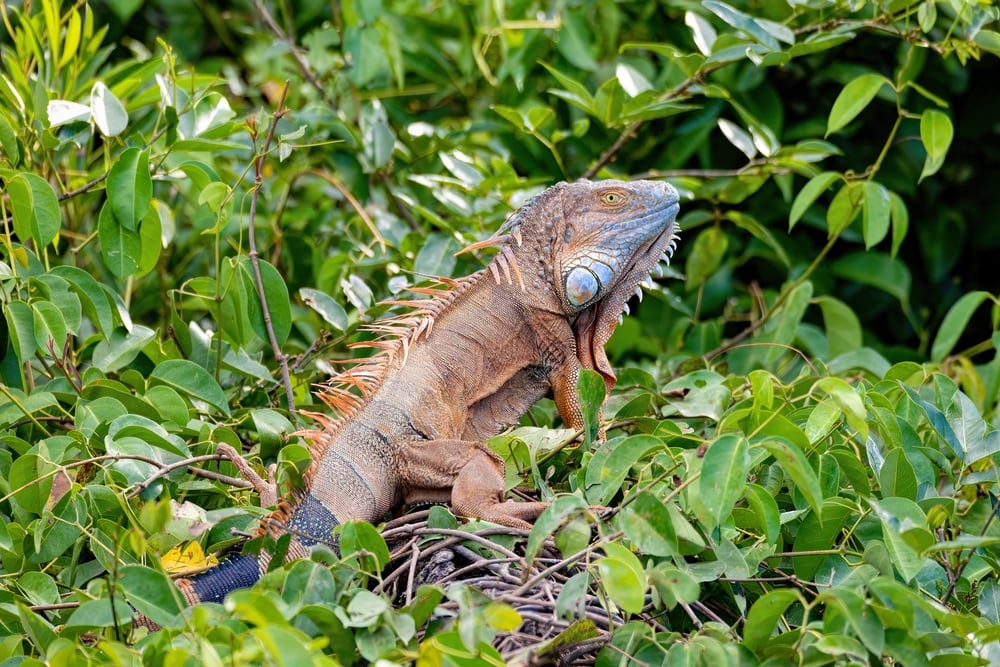Iguanas are fascinating reptiles known for their impressive sizes. The blue iguana can grow up to 5 feet in length and weigh over 30 pounds, making it one of the largest types of iguanas. On the other hand, female iguanas are generally smaller, reaching an average length of 3 feet and weighing over 10 pounds.
Different species of iguanas exhibit varying growth patterns. For example, iguanas typically achieve full size around 4 years of age, but some may continue to grow for up to 7 or 8 years. Their growth rates are not uniform; they tend to grow quickly in the early years before growth slows considerably.
The overall sizes of iguanas can differ based on their environment, their diet, and their species. For instance, some iguanas reach a total length of about 5 to 7 feet and weigh between 13.2 to 17.6 pounds. For more information on the size and types of iguanas, you can explore different iguana species and their growth. This diversity in size and growth among iguana species makes them a unique subject of study and a captivating pet.
Iguana Growth Fundamentals
Iguanas grow to impressive sizes, influenced by species, diet, and environmental factors. Understanding these elements can aid in optimizing their health and growth.
Factors Influencing Growth
Species and Genetics
Different species of iguanas grow to various lengths. For instance, the blue iguana can grow up to 5 feet in length and weigh over 30 pounds. In contrast, other species may range from 5 inches to 7 feet depending on their genetics and intrinsic growth patterns. Knowing the species-specific growth potential is crucial for expectations on size and care.
Diet and Nutrition
A well-balanced diet significantly impacts an iguana’s growth. Leafy greens, vegetables, and fruits provide essential nutrients. Calcium and vitamin D3 are especially crucial for bone development. Inadequate nutrition can result in stunted growth or health issues. Providing a variety of fresh, nutritious foods supports optimal health and growth.
Environmental Conditions
Temperature, humidity, and light play pivotal roles in iguana growth. Proper heat and UVB lighting replicate their natural habitats, aiding digestion and calcium absorption. Cooler temperatures can slow down their metabolic rate, affecting growth. Maintaining suitable environmental conditions ensures they develop healthily and reach their growth potential.

Species-Specific Size Profiles
Different iguana species have varied size ranges and growth patterns. This section outlines the size characteristics of common green iguanas, smaller iguana species, and larger iguana species.
Common Green Iguana
The common green iguana is one of the most popular species kept as pets. They typically grow to impressive sizes. An adult can reach up to 5-7 feet in length from snout to tail and weigh around 10-20 pounds.
Male green iguanas are significantly larger than females. Males can exceed 7 feet, while females average closer to 5 feet. Their growth rate is rapid during the first few years, and they tend to reach full size by around 4-7 years.
Smaller Iguana Species
Some iguana species remain relatively small compared to their larger relatives. For instance, the desert iguana reaches about 16 inches in length. Other examples include the spiny-tailed iguana, typically growing to about 10-18 inches.
These smaller species are often easier to manage as pets due to their size. They also have more modest weight ranges, usually between 0.5 to 3 pounds. Their smaller size is advantageous for both hobbyists and new pet owners seeking a more manageable reptile companion.
Larger Iguana Species
Certain iguana species can grow exceptionally large. The blue iguana, native to the Cayman Islands, can reach up to 5 feet in length and weigh over 30 pounds. These iguanas are critically endangered and less commonly seen in captivity.
The rhinoceros iguana is another large species, reaching lengths of up to 4.5 feet and weighing around 10-20 pounds. These iguanas have a unique horn-like structure on their snouts, hence their name. Larger species often require specialized care and more significant habitats to accommodate their size, making them less suitable for the average pet owner.
Risks and Responsibilities
Large iguanas present various challenges and potential dangers. Effective population control is also essential for maintaining ecological balance and managing the impacts on habitats.
Handling Large Iguanas
Handling large iguanas requires significant care and expertise. Their powerful tails, sharp claws, and strong jaws can cause acute injuries. They need a spacious enclosure to move freely and avoid stress. Mishandling can lead to aggressive behavior and potential attacks.
Owners must wear protective gear when interacting with them and ensure they are supported properly to prevent injury to both the iguana and the handler. Regular veterinary check-ups are essential to monitor health and prevent diseases.
Population Control and Management
Iguanas, particularly the green iguana, have become an invasive species in various regions, notably in South Florida. While the iguana population in Florida may seem harmless and even fascinating to observe, they pose significant threats to local ecosystems and public health, making it essential for property owners to consider humane removal strategies.
One of the primary concerns with iguanas is their potential to carry diseases. Iguanas can harbor bacteria such as Salmonella, which can be transmitted to humans through direct contact or contaminated surfaces. This poses a considerable health risk, especially to children, the elderly, and individuals with compromised immune systems. In addition to Salmonella, iguanas can also carry parasites that may affect other wildlife and pets, further complicating the ecological balance.
Beyond health concerns, iguanas are notorious for their destructive impact on local ecosystems. They are voracious herbivores, feeding on a wide variety of plants, including native and ornamental species. This feeding behavior can lead to significant damage to gardens, landscaping, and agricultural crops. Moreover, iguanas often outcompete native species for food resources, leading to a decline in biodiversity. Their burrowing habits can also undermine the structural integrity of sidewalks, seawalls, and foundations, causing costly damage to infrastructure.
Given these issues, it is crucial for property owners to consider humane methods for removing iguanas. Humane removal not only addresses the immediate problem but also ensures that the animals are treated ethically. Methods such as live trapping and relocation, habitat modification, and exclusion techniques can be effective in managing iguana populations without causing harm to the animals. It is also advisable to consult with wildlife professionals to develop a comprehensive and humane management plan.
In conclusion, while iguanas may appear to be benign inhabitants of our surroundings, their presence can lead to significant health risks and ecological disruption. By taking proactive and humane measures to remove iguanas from properties, which can be done by hiring a company for iguana control services, individuals can help protect public health and preserve the integrity of local ecosystems.


